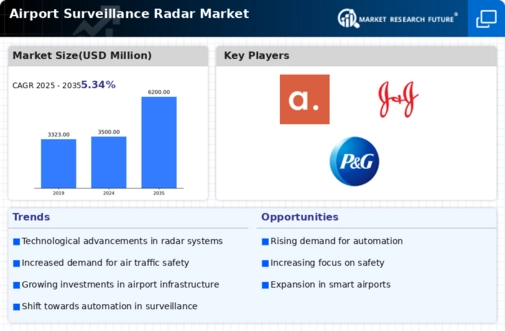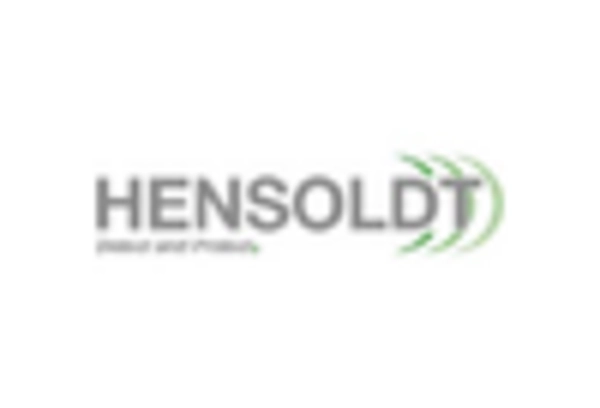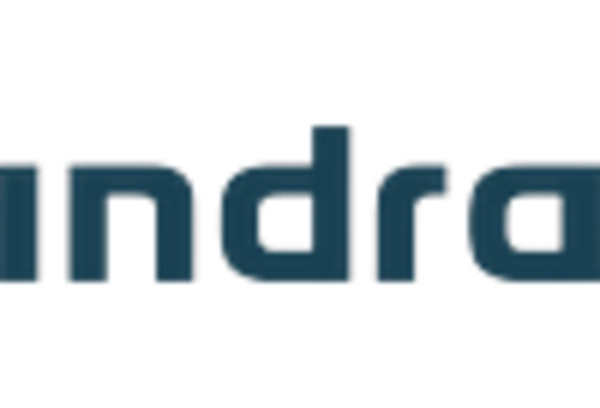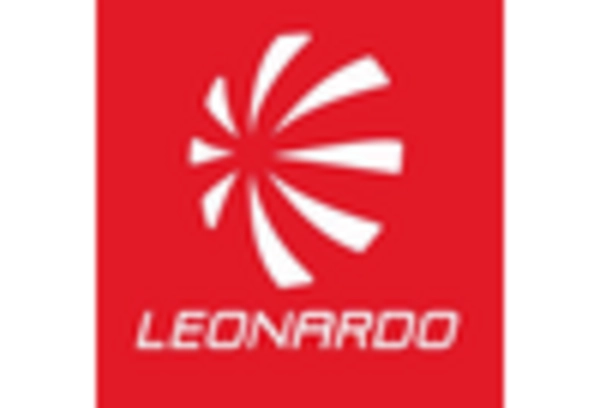-
EXECUTIVE SUMMARY
-
MARKET ATTRACTIVENESS ANALYSIS
- GLOBAL AIRPORT SURVEILLANCE RADAR MARKET, BY TYPE
- GLOBAL
-
AIRPORT SURVEILLANCE RADAR MARKET, BY APPLICATION
-
GLOBAL AIRPORT
-
SURVEILLANCE RADAR MARKET, BY REGION
-
MARKET INTRODUCTION
-
DEFINITION
-
SCOPE OF THE STUDY
-
RESEARCH OBJECTIVE
-
MARKET STRUCTURE
-
KEY BUYING CRITERIA
-
RESEARCH
-
METHODOLOGY
-
RESEARCH PROCESS
-
PRIMARY RESEARCH
-
SECONDARY RESEARCH
-
MARKET SIZE ESTIMATION
-
FORECAST
-
MODEL
-
LIST OF ASSUMPTIONS
-
MARKET INSIGHTS
-
MARKET DYNAMICS
-
INTRODUCTION
-
DRIVERS
- INCREASE IN DEFENSE EXPENDITURE
- DEVELOPMENT OF NEW
- DRIVERS IMPACT ANALYSIS
- HIGH COSTS OF INSTALLATION AND OPERATION
-
& EXISTING AIRPORTS
-
RESTRAINTS
-
RESTRAINTS IMPACT ANALYSIS
-
OPPORTUNITIES
- INTEGRATION
- EMERGENCE OF 3D RADAR SYSTEMS
-
OF GPS TECHNOLOGY WITH RADAR SYSTEMS
-
MARKET FACTOR ANALYSIS
-
SUPPLY CHAIN
- COMPONENT/MATERIAL
- MANUFACTURING AND ASSEMBLY
- SUPPLY AND DISTRIBUTION
- END USE
-
SUPPLY
-
PORTER’S FIVE FORCES MODEL
- BARGAINING POWER OF SUPPLIERS
- THREAT OF SUBSTITUTES
-
THREAT OF NEW ENTRANTS
-
BARGAINING POWER OF BUYERS
-
INTENSITY OF RIVALRY
-
GLOBAL AIRPORT SURVEILLANCE RADAR MARKET, BY TYPE
-
OVERVIEW
-
GLOBAL AIRPORT SURVEILLANCE RADAR MARKET, BY
-
TYPE, 2020–2030 (USD MILLION)
-
PRIMARY RADARS
- PRIMARY RADARS: MARKET ESTIMATES & FORECAST, BY REGION, 2020–2030
-
PRIMARY RADARS: MARKET ESTIMATES & FORECAST, 2020–2030 (USD MILLION)
-
(USD MILLION)
-
SECONDARY RADARS
- SECONDARY RADARS:
-
MARKET ESTIMATES & FORECAST, 2020–2030 (USD MILLION)
-
SECONDARY RADARS: MARKET ESTIMATES & FORECAST, BY REGION, 2020–2030 (USD
-
MILLION)
-
GLOBAL AIRPORT SURVEILLANCE RADAR MARKET, BY APPLICATION
-
OVERVIEW
-
GLOBAL AIRPORT SURVEILLANCE RADAR MARKET, BY
-
APPLICATION, 2020–2030 (USD MILLION)
-
CIVIL & COMMERCIAL
- CIVIL & COMMERCIAL AIRPORTS: MARKET ESTIMATES &
- CIVIL & COMMERCIAL
-
AIRPORTS
-
FORECAST, 2020–2030 (USD MILLION)
-
AIRPORTS: MARKET ESTIMATES & FORECAST, BY REGION, 2020–2030 (USD MILLION)
-
MILITARY AIRBASES & AIRFIELDS
- MILITARY AIRBASES
- MILITARY AIRBASES & AIRFIELDS: MARKET ESTIMATES & FORECAST,
-
& AIRFIELDS: MARKET ESTIMATES & FORECAST, 2020–2030 (USD MILLION)
-
BY REGION, 2020–2030 (USD MILLION)
-
GLOBAL AIRPORT SURVEILLANCE
-
RADAR MARKET, BY REGION
-
OVERVIEW
- NORTH AMERICA
- NORTH AMERICA: AIRPORT SURVEILLANCE RADAR MARKET, BY COUNTRY, 2020–2030
- NORTH AMERICA: AIRPORT SURVEILLANCE RADAR MARKET,
- NORTH AMERICA: AIRPORT SURVEILLANCE
-
(USD MILLION)
-
BY TYPE, 2020–2030 (USD MILLION)
-
RADAR MARKET, BY APPLICATION, 2020–2030 (USD MILLION)
-
(USD MILLION)
-
US
-
US: AIRPORT SURVEILLANCE RADAR MARKET, BY TYPE, 2020–2030
-
US: AIRPORT SURVEILLANCE RADAR MARKET, BY APPLICATION,
-
CANADA
-
CANADA:
-
AIRPORT SURVEILLANCE RADAR MARKET, BY TYPE, 2020–2030 (USD MILLION)
-
(USD MILLION)
-
CANADA: AIRPORT SURVEILLANCE RADAR MARKET, BY APPLICATION, 2020–2030
-
EUROPE
- EUROPE: AIRPORT SURVEILLANCE
-
RADAR MARKET, BY COUNTRY, 2020–2030 (USD MILLION)
-
EUROPE:
-
AIRPORT SURVEILLANCE RADAR MARKET, BY TYPE, 2020–2030 (USD MILLION)
-
(USD MILLION)
-
EUROPE: AIRPORT SURVEILLANCE RADAR MARKET, BY APPLICATION, 2020–2030
-
UK
-
UK: AIRPORT SURVEILLANCE RADAR
-
MARKET, BY TYPE, 2020–2030 (USD MILLION)
-
UK: AIRPORT SURVEILLANCE
-
RADAR MARKET, BY APPLICATION, 2020–2030 (USD MILLION)
-
(USD MILLION)
-
APPLICATION, 2020–2030 (USD MILLION)
-
GERMANY
-
GERMANY: AIRPORT SURVEILLANCE RADAR MARKET, BY TYPE, 2020–2030
-
GERMANY: AIRPORT SURVEILLANCE RADAR MARKET, BY
-
FRANCE
-
FRANCE: AIRPORT SURVEILLANCE RADAR MARKET, BY TYPE, 2020–2030 (USD MILLION)
-
(USD MILLION)
-
FRANCE: AIRPORT SURVEILLANCE RADAR MARKET, BY APPLICATION, 2020–2030
-
RUSSIA
-
RUSSIA: AIRPORT SURVEILLANCE
-
RADAR MARKET, BY TYPE, 2020–2030 (USD MILLION)
-
RUSSIA:
-
AIRPORT SURVEILLANCE RADAR MARKET, BY APPLICATION, 2020–2030 (USD MILLION)
-
REST OF EUROPE
-
REST OF EUROPE: AIRPORT SURVEILLANCE
-
RADAR MARKET, BY TYPE, 2020–2030 (USD MILLION)
-
REST OF
-
EUROPE: AIRPORT SURVEILLANCE RADAR MARKET, BY APPLICATION, 2020–2030 (USD
-
MILLION)
-
ASIA-PACIFIC
- ASIA-PACIFIC: AIRPORT SURVEILLANCE
-
RADAR MARKET, BY COUNTRY, 2020–2030 (USD MILLION)
-
ASIA-PACIFIC:
-
AIRPORT SURVEILLANCE RADAR MARKET, BY TYPE, 2020–2030 (USD MILLION)
-
(USD MILLION)
-
ASIA-PACIFIC: AIRPORT SURVEILLANCE RADAR MARKET, BY APPLICATION, 2020–2030
-
CHINA
-
CHINA: AIRPORT SURVEILLANCE
-
RADAR MARKET, BY TYPE, 2020–2030 (USD MILLION)
-
CHINA: AIRPORT
-
SURVEILLANCE RADAR MARKET, BY APPLICATION, 2020–2030 (USD MILLION)
-
INDIA
-
INDIA: AIRPORT SURVEILLANCE RADAR MARKET, BY TYPE,
-
INDIA: AIRPORT SURVEILLANCE RADAR
-
MARKET, BY APPLICATION, 2020–2030 (USD MILLION)
-
(USD MILLION)
-
JAPAN
-
JAPAN: AIRPORT SURVEILLANCE RADAR MARKET, BY TYPE, 2020–2030
-
JAPAN: AIRPORT SURVEILLANCE RADAR MARKET, BY APPLICATION,
-
SOUTH KOREA
-
SOUTH
-
KOREA: AIRPORT SURVEILLANCE RADAR MARKET, BY TYPE, 2020–2030 (USD MILLION)
-
SOUTH KOREA: AIRPORT SURVEILLANCE RADAR MARKET, BY APPLICATION,
-
REST OF ASIA-PACIFIC
-
REST OF ASIA-PACIFIC: AIRPORT SURVEILLANCE RADAR MARKET, BY TYPE, 2020–2030
-
(USD MILLION)
-
REST OF ASIA-PACIFIC: AIRPORT SURVEILLANCE RADAR
-
MARKET, BY APPLICATION, 2020–2030 (USD MILLION)
-
MIDDLE EAST
- MIDDLE EAST & AFRICA: AIRPORT SURVEILLANCE RADAR
-
& AFRICA
-
MARKET, BY COUNTRY, 2020–2030 (USD MILLION)
-
MIDDLE EAST &
-
AFRICA: AIRPORT SURVEILLANCE RADAR MARKET, BY TYPE, 2020–2030 (USD MILLION)
-
MIDDLE EAST & AFRICA: AIRPORT SURVEILLANCE RADAR MARKET, BY APPLICATION,
-
UAE
-
UAE: AIRPORT
-
SURVEILLANCE RADAR MARKET, BY TYPE, 2020–2030 (USD MILLION)
-
UAE: AIRPORT SURVEILLANCE RADAR MARKET, BY APPLICATION, 2020–2030 (USD MILLION)
-
SAUDI ARABIA
-
SAUDI ARABIA: AIRPORT SURVEILLANCE
-
RADAR MARKET, BY TYPE, 2020–2030 (USD MILLION)
-
SAUDI ARABIA:
-
AIRPORT SURVEILLANCE RADAR MARKET, BY APPLICATION, 2020–2030 (USD MILLION)
-
REST OF THE MIDDLE EAST & AFRICA
-
REST OF THE
-
MIDDLE EAST & AFRICA: AIRPORT SURVEILLANCE RADAR MARKET, BY TYPE, 2020–2030
-
(USD MILLION)
-
REST OF THE MIDDLE EAST & AFRICA: AIRPORT SURVEILLANCE
-
RADAR MARKET, BY APPLICATION, 2020–2030 (USD MILLION)
-
LATIN
- LATIN AMERICA: AIRPORT SURVEILLANCE RADAR MARKET, BY COUNTRY,
- LATIN AMERICA: AIRPORT SURVEILLANCE
-
AMERICA
-
RADAR MARKET, BY TYPE, 2020–2030 (USD MILLION)
-
LATIN AMERICA:
-
AIRPORT SURVEILLANCE RADAR MARKET, BY APPLICATION, 2020–2030 (USD MILLION)
-
BY TYPE, 2020–2030 (USD MILLION)
-
BRAZIL
-
BRAZIL: AIRPORT SURVEILLANCE RADAR MARKET,
-
BRAZIL: AIRPORT SURVEILLANCE
-
RADAR MARKET, BY APPLICATION, 2020–2030 (USD MILLION)
-
(USD MILLION)
-
MEXICO
-
MEXICO: AIRPORT SURVEILLANCE RADAR MARKET, BY TYPE, 2020–2030
-
MEXICO: AIRPORT SURVEILLANCE RADAR MARKET, BY APPLICATION,
-
REST OF LATIN AMERICA
-
REST OF LATIN AMERICA: AIRPORT SURVEILLANCE RADAR MARKET, BY TYPE, 2020–2030
-
(USD MILLION)
-
REST OF LATIN AMERICA: AIRPORT SURVEILLANCE RADAR
-
MARKET, BY APPLICATION, 2020–2030 (USD MILLION)
-
COMPETITIVE
-
LANDSCAPE
-
COMPETITIVE OVERVIEW
-
COMPETITIVE BENCHMARKING
-
MARKET SHARE ANALYSIS
-
MAJOR GROWTH STRATEGIES IN THE
-
GLOBAL AIRPORT SURVEILLANCE RADAR MARKET
-
LEADING PLAYERS IN TERMS
-
OF NUMBER OF DEVELOPMENTS IN THE GLOBAL AIRPORT SURVEILLANCE RADAR MARKET
-
KEY DEVELOPMENTS & GROWTH STRATEGIES
- CONTRACTS &
- NEW PRODUCT DEVELOPMENTS/LAUNCHES
-
AGREEMENTS
-
COLLABORATIONS/ EXPANSIONS/PARTNERSHIPS/JOINT VENTURES
-
COMPANY PROFILES
-
BAE SYSTEMS
- COMPANY OVERVIEW
- FINANCIAL
- PRODUCTS/SERVICES OFFERED
- KEY DEVELOPMENTS
- SWOT ANALYSIS
- KEY STRATEGIES
-
OVERVIEW
-
NORTHROP
- COMPANY OVERVIEW
- FINANCIAL
- PRODUCTS/SERVICES OFFERED
- KEY DEVELOPMENTS
- SWOT ANALYSIS
- KEY STRATEGIES
-
GRUMMAN CORPORATION
-
OVERVIEW
-
THALES
- COMPANY OVERVIEW
- FINANCIAL OVERVIEW
- PRODUCTS/SERVICES OFFERED
- KEY DEVELOPMENTS
- SWOT ANALYSIS
- KEY STRATEGIES
-
GROUP
-
LOCKHEED
- COMPANY OVERVIEW
- FINANCIAL
- PRODUCTS/SERVICES OFFERED
- KEY DEVELOPMENTS
- SWOT ANALYSIS
- KEY STRATEGIES
-
MARTIN CORPORATION
-
OVERVIEW
-
RAYTHEON
- COMPANY OVERVIEW
- FINANCIAL OVERVIEW
- PRODUCTS/SERVICES OFFERED
- KEY DEVELOPMENTS
- SWOT ANALYSIS
- KEY STRATEGIES
-
COMPANY
-
LEONARDO
- COMPANY OVERVIEW
- FINANCIAL OVERVIEW
- PRODUCTS/SERVICES OFFERED
- KEY DEVELOPMENTS
-
SPA
-
SWOT ANALYSIS
-
INC.
-
TECHNOSYSTEMS INC.
-
OVERVIEW
-
SURVEILLANCE SYSTEMS LTD
-
OVERVIEW
-
CORPORATION
-
KEY STRATEGIES
-
L3HARRIS TECHNOLOGIES,
- COMPANY OVERVIEW
- FINANCIAL OVERVIEW
- PRODUCTS/SERVICES OFFERED
- KEY DEVELOPMENTS
- SWOT ANALYSIS
- KEY STRATEGIES
-
INTELCAN
- COMPANY OVERVIEW
- FINANCIAL
- PRODUCTS/SERVICES OFFERED
- KEY DEVELOPMENTS
- SWOT ANALYSIS
- KEY STRATEGIES
-
BLIGHTER
- COMPANY OVERVIEW
- FINANCIAL
- PRODUCTS/SERVICES OFFERED
- KEY DEVELOPMENTS
- SWOT ANALYSIS
- KEY STRATEGIES
-
NEC
- COMPANY OVERVIEW
- FINANCIAL OVERVIEW
- PRODUCTS/SERVICES OFFERED
- KEY DEVELOPMENTS
- SWOT ANALYSIS
- KEY STRATEGIES
-
OTHER
-
PROMINENT PLAYERS IN THE MARKET
-
HENSOLDT
-
SHOGHI
-
COMMUNICATIONS LTD
-
TERMA
-
ASELSAN AŞ
-
EASAT RADAR SYSTEMS LIMITED
-
AIRBUS SAS
-
DETECT, INC.
-
SAAB AB
-
ISRAEL AEROSPACE INDUSTRIES LTD
-
TELEPHONICS CORPORATION
-
INDRA SISTEMAS, SA
-
List of
-
Tables
-
PRIMARY INTERVIEWS
-
LIST OF ASSUMPTIONS
-
GLOBAL AIRPORT SURVEILLANCE RADAR MARKET, BY TYPE, 2020–2030
-
(USD MILLION)
-
PRIMARY RADARS: MARKET ESTIMATES & FORECAST,
-
PRIMARY RADARS: MARKET ESTIMATES
-
& FORECAST, BY REGION, 2020–2030 (USD MILLION)
-
SECONDARY
-
RADARS: MARKET ESTIMATES & FORECAST, 2020–2030 (USD MILLION)
-
SECONDARY RADARS: MARKET ESTIMATES & FORECAST, BY REGION, 2020–2030
-
(USD MILLION)
-
GLOBAL AIRPORT SURVEILLANCE RADAR MARKET, BY APPLICATION,
-
CIVIL & COMMERCIAL AIRPORTS:
-
MARKET ESTIMATES & FORECAST, 2020–2030 (USD MILLION)
-
TABLE
-
CIVIL & COMMERCIAL AIRPORTS: MARKET ESTIMATES & FORECAST, BY REGION,
-
MILITARY AIRBASES & AIRFIELDS:
-
MARKET ESTIMATES & FORECAST, 2020–2030 (USD MILLION)
-
TABLE
-
MILITARY AIRBASES & AIRFIELDS: MARKET ESTIMATES & FORECAST, BY REGION,
-
GLOBAL AIRPORT SURVEILLANCE RADAR
-
MARKET, BY REGION, 2020–2030 (USD MILLION)
-
NORTH AMERICA:
-
AIRPORT SURVEILLANCE RADAR MARKET, BY COUNTRY, 2020–2030 (USD MILLION)
-
NORTH AMERICA: AIRPORT SURVEILLANCE RADAR MARKET, BY TYPE, 2020–2030
-
(USD MILLION)
-
NORTH AMERICA: AIRPORT SURVEILLANCE RADAR MARKET,
-
BY APPLICATION, 2020–2030 (USD MILLION)
-
US: AIRPORT SURVEILLANCE
-
RADAR MARKET, BY TYPE, 2020–2030 (USD MILLION)
-
US: AIRPORT
-
SURVEILLANCE RADAR MARKET, BY APPLICATION, 2020–2030 (USD MILLION)
-
CANADA: AIRPORT SURVEILLANCE RADAR MARKET, BY TYPE, 2020–2030 (USD
-
MILLION)
-
CANADA: AIRPORT SURVEILLANCE RADAR MARKET, BY APPLICATION,
-
EUROPE: AIRPORT SURVEILLANCE RADAR
-
MARKET, BY COUNTRY, 2020–2030 (USD MILLION)
-
EUROPE: AIRPORT
-
SURVEILLANCE RADAR MARKET, BY TYPE, 2020–2030 (USD MILLION)
-
TABLE
-
EUROPE: AIRPORT SURVEILLANCE RADAR MARKET, BY APPLICATION, 2020–2030 (USD
-
MILLION)
-
UK: AIRPORT SURVEILLANCE RADAR MARKET, BY TYPE, 2020–2030
-
(USD MILLION)
-
UK: AIRPORT SURVEILLANCE RADAR MARKET, BY APPLICATION,
-
GERMANY: AIRPORT SURVEILLANCE
-
RADAR MARKET, BY TYPE, 2020–2030 (USD MILLION)
-
GERMANY:
-
AIRPORT SURVEILLANCE RADAR MARKET, BY APPLICATION, 2020–2030 (USD MILLION)
-
FRANCE: AIRPORT SURVEILLANCE RADAR MARKET, BY TYPE, 2020–2030
-
(USD MILLION)
-
FRANCE: AIRPORT SURVEILLANCE RADAR MARKET, BY
-
APPLICATION, 2020–2030 (USD MILLION)
-
RUSSIA: AIRPORT SURVEILLANCE
-
RADAR MARKET, BY TYPE, 2020–2030 (USD MILLION)
-
RUSSIA:
-
AIRPORT SURVEILLANCE RADAR MARKET, BY APPLICATION, 2020–2030 (USD MILLION)
-
REST OF EUROPE: AIRPORT SURVEILLANCE RADAR MARKET, BY TYPE, 2020–2030
-
(USD MILLION)
-
REST OF EUROPE: AIRPORT SURVEILLANCE RADAR MARKET,
-
BY APPLICATION, 2020–2030 (USD MILLION)
-
ASIA-PACIFIC:
-
AIRPORT SURVEILLANCE RADAR MARKET, BY COUNTRY, 2020–2030 (USD MILLION)
-
ASIA-PACIFIC: AIRPORT SURVEILLANCE RADAR MARKET, BY TYPE, 2020–2030
-
(USD MILLION)
-
ASIA-PACIFIC: AIRPORT SURVEILLANCE RADAR MARKET,
-
BY APPLICATION, 2020–2030 (USD MILLION)
-
CHINA: AIRPORT
-
SURVEILLANCE RADAR MARKET, BY TYPE, 2020–2030 (USD MILLION)
-
TABLE
-
CHINA: AIRPORT SURVEILLANCE RADAR MARKET, BY APPLICATION, 2020–2030 (USD
-
MILLION)
-
INDIA: AIRPORT SURVEILLANCE RADAR MARKET, BY TYPE,
-
INDIA: AIRPORT SURVEILLANCE RADAR
-
MARKET, BY APPLICATION, 2020–2030 (USD MILLION)
-
JAPAN:
-
AIRPORT SURVEILLANCE RADAR MARKET, BY TYPE, 2020–2030 (USD MILLION)
-
JAPAN: AIRPORT SURVEILLANCE RADAR MARKET, BY APPLICATION, 2020–2030
-
(USD MILLION)
-
SOUTH KOREA: AIRPORT SURVEILLANCE RADAR MARKET,
-
BY TYPE, 2020–2030 (USD MILLION)
-
SOUTH KOREA: AIRPORT
-
SURVEILLANCE RADAR MARKET, BY APPLICATION, 2020–2030 (USD MILLION)
-
REST OF ASIA-PACIFIC: AIRPORT SURVEILLANCE RADAR MARKET, BY TYPE, 2020–2030
-
(USD MILLION)
-
REST OF ASIA-PACIFIC: AIRPORT SURVEILLANCE RADAR
-
MARKET, BY APPLICATION, 2020–2030 (USD MILLION)
-
MIDDLE
-
EAST & AFRICA: AIRPORT SURVEILLANCE RADAR MARKET, BY COUNTRY, 2020–2030
-
(USD MILLION)
-
MIDDLE EAST & AFRICA: AIRPORT SURVEILLANCE
-
RADAR MARKET, BY TYPE, 2020–2030 (USD MILLION)
-
MIDDLE
-
EAST & AFRICA: AIRPORT SURVEILLANCE RADAR MARKET, BY APPLICATION, 2020–2030
-
(USD MILLION)
-
UAE: AIRPORT SURVEILLANCE RADAR MARKET, BY TYPE,
-
UAE: AIRPORT SURVEILLANCE RADAR
-
MARKET, BY APPLICATION, 2020–2030 (USD MILLION)
-
SAUDI
-
ARABIA: AIRPORT SURVEILLANCE RADAR MARKET, BY TYPE, 2020–2030 (USD MILLION)
-
SAUDI ARABIA: AIRPORT SURVEILLANCE RADAR MARKET, BY APPLICATION,
-
REST OF THE MIDDLE EAST &
-
AFRICA: AIRPORT SURVEILLANCE RADAR MARKET, BY TYPE, 2020–2030 (USD MILLION)
-
REST OF THE MIDDLE EAST & AFRICA: AIRPORT SURVEILLANCE RADAR
-
MARKET, BY APPLICATION, 2020–2030 (USD MILLION)
-
LATIN
-
AMERICA: AIRPORT SURVEILLANCE RADAR MARKET, BY COUNTRY, 2020–2030 (USD MILLION)
-
LATIN AMERICA: AIRPORT SURVEILLANCE RADAR MARKET, BY TYPE, 2020–2030
-
(USD MILLION)
-
LATIN AMERICA: AIRPORT SURVEILLANCE RADAR MARKET,
-
BY APPLICATION, 2020–2030 (USD MILLION)
-
BRAZIL: AIRPORT
-
SURVEILLANCE RADAR MARKET, BY TYPE, 2020–2030 (USD MILLION)
-
TABLE
-
BRAZIL: AIRPORT SURVEILLANCE RADAR MARKET, BY APPLICATION, 2020–2030 (USD
-
MILLION)
-
MEXICO: AIRPORT SURVEILLANCE RADAR MARKET, BY TYPE,
-
MEXICO: AIRPORT SURVEILLANCE RADAR
-
MARKET, BY APPLICATION, 2020–2030 (USD MILLION)
-
REST OF
-
LATIN AMERICA: AIRPORT SURVEILLANCE RADAR MARKET, BY TYPE, 2020–2030 (USD
-
MILLION)
-
REST OF LATIN AMERICA: AIRPORT SURVEILLANCE RADAR MARKET,
-
BY APPLICATION, 2020–2030 (USD MILLION)
-
THE MOST ACTIVE
-
PLAYERS IN THE GLOBAL AIRPORT SURVEILLANCE RADAR MARKET
-
CONTRACTS
-
& AGREEMENTS
-
NEW PRODUCT DEVELOPMENTS/LAUNCHES
-
COLLABORATIONS/EXPANSIONS/PARTNERSHIPS/JOINT VENTURES
-
TABLE
-
BAE SYSTEMS: PRODUCTS/SERVICES OFFERED
-
BAE SYSTEMS: KEY DEVELOPMENTS
-
NORTHROP GRUMMAN CORPORATION: PRODUCTS/SERVICES OFFERED
-
THALES GROUP: PRODUCTS/SERVICES OFFERED
-
THALES GROUP:
-
KEY DEVELOPMENTS
-
LOCKHEED MARTIN CORPORATION: PRODUCTS/SERVICES
-
OFFERED
-
LOCKHEED MARTIN CORPORATION: KEY DEVELOPMENTS
-
RAYTHEON COMPANY: PRODUCTS/SERVICES OFFERED
-
RAYTHEON
-
COMPANY: KEY DEVELOPMENTS
-
LEONARDO SPA: PRODUCTS/SERVICES OFFERED
-
LEONARDO SPA: KEY DEVELOPMENTS
-
L3HARRIS TECHNOLOGIES,
-
INC.: PRODUCTS/SERVICES OFFERED
-
L3HARRIS TECHNOLOGIES, INC.:
-
KEY DEVELOPMENTS
-
INTELCAN TECHNOSYSTEMS INC.: PRODUCTS/SERVICES
-
OFFERED
-
BLIGHTER SURVEILLANCE SYSTEMS LTD: PRODUCTS/SERVICES
-
OFFERED
-
BLIGHTER SURVEILLANCE SYSTEMS LTD: KEY DEVELOPMENTS
-
NEC CORPORATION: PRODUCTS/SERVICES OFFERED
-
TABLE 86
-
NEC CORPORATION: KEY DEVELOPMENTS
-
HENSOLDT: COMPANY OVERVIEW
-
AND PRODUCTS/SERVICES OFFERED
-
SHOGHI COMMUNICATIONS LTD: COMPANY
-
OVERVIEW AND PRODUCTS/SERVICES OFFERED
-
TERMA.: COMPANY OVERVIEW
-
AND PRODUCTS/SERVICES OFFERED
-
ASELSAN A.Ş: COMPANY OVERVIEW
-
AND PRODUCTS/SERVICES OFFERED
-
EASAT RADAR SYSTEMS LIMITED: COMPANY
-
OVERVIEW AND PRODUCTS/SERVICES OFFERED
-
AIRBUS SAS: COMPANY OVERVIEW
-
AND PRODUCTS/SERVICES OFFERED
-
DETECT, INC.: COMPANY OVERVIEW
-
AND PRODUCTS/SERVICES OFFERED
-
SAAB AB: COMPANY OVERVIEW AND
-
PRODUCTS/SERVICES OFFERED
-
ISRAEL AEROSPACE INDUSTRIES LTD: COMPANY
-
OVERVIEW AND PRODUCTS/SERVICES OFFERED
-
TELEPHONICS CORPORATION:
-
COMPANY OVERVIEW AND PRODUCTS/SERVICES OFFERED
-
INDRA SISTEMAS,
-
S.A.: COMPANY OVERVIEW AND PRODUCTS/SERVICES OFFERED
-
List of Figures
-
MARKET SYNOPSIS
-
MARKET ATTRACTIVENESS ANALYSIS:
-
GLOBAL AIRPORT SURVEILLANCE RADAR MARKET
-
GLOBAL AIRPORT SURVEILLANCE
-
RADAR MARKET ANALYSIS, BY TYPE
-
GLOBAL AIRPORT SURVEILLANCE RADAR
-
MARKET ANALYSIS, BY APPLICATION
-
GLOBAL AIRPORT SURVEILLANCE
-
RADAR MARKET ANALYSIS, BY REGION
-
GLOBAL AIRPORT SURVEILLANCE
-
RADAR MARKET: STRUCTURE
-
KEY BUYING CRITERIA FOR AIRPORT SURVEILLANCE
-
RADAR
-
RESEARCH PROCESS
-
TOP-DOWN & BOTTOM-UP
-
APPROACHES
-
NORTH AMERICA: AIRPORT SURVEILLANCE RADAR MARKET
-
SIZE & MARKET SHARE, BY COUNTRY (2020 VS 2030)
-
EUROPE:
-
AIRPORT SURVEILLANCE RADAR MARKET SIZE & MARKET SHARE, BY COUNTRY (2020 VS 2030)
-
ASIA-PACIFIC: AIRPORT SURVEILLANCE RADAR MARKET SIZE & MARKET
-
SHARE, BY COUNTRY (2020 VS 2030)
-
MIDDLE EAST & AFRICA:
-
AIRPORT SURVEILLANCE RADAR MARKET SIZE & MARKET SHARE, BY COUNTRY (2020 VS 2030)
-
LATIN AMERICA: AIRPORT SURVEILLANCE RADAR MARKET SIZE & MARKET
-
SHARE, BY COUNTRY (2020 VS 2030)
-
MARKET DYNAMICS OVERVIEW
-
CHANGE IN MILITARY SPENDING FOR TOP 10 COUNTRIES (2007–2020)
-
DRIVERS IMPACT ANALYSIS: GLOBAL AIRPORT SURVEILLANCE RADAR MARKET
-
RESTRAINTS IMPACT ANALYSIS: GLOBAL AIRPORT SURVEILLANCE RADAR
-
MARKET
-
GLOBAL AIRPORT SURVEILLANCE RADAR MARKET: SUPPLY CHAIN
-
PORTER'S FIVE FORCES ANALYSIS OF THE GLOBAL AIRPORT SURVEILLANCE
-
RADAR MARKET
-
GLOBAL AIRPORT SURVEILLANCE RADAR MARKET, BY TYPE,
-
GLOBAL AIRPORT SURVEILLANCE RADAR MARKET, BY
-
APPLICATION, 2020 (% SHARE)
-
GLOBAL AIRPORT SURVEILLANCE RADAR
-
MARKET SHARE, BY REGION, 2020 (% SHARE)
-
NORTH AMERICA: AIRPORT
-
SURVEILLANCE RADAR MARKET SHARE, BY COUNTRY, 2020 (% SHARE)
-
FIGURE 25
-
EUROPE: AIRPORT SURVEILLANCE RADAR MARKET SHARE, BY COUNTRY, 2020 (% SHARE)
-
ASIA-PACIFIC: AIRPORT SURVEILLANCE RADAR MARKET SHARE, BY COUNTRY, 2020
-
(% SHARE)
-
MIDDLE EAST & AFRICA: AIRPORT SURVEILLANCE RADAR
-
MARKET SHARE, BY COUNTRY, 2020 (% SHARE)
-
LATIN AMERICA: AIRPORT
-
SURVEILLANCE RADAR MARKET SHARE, BY COUNTRY, 2020 (% SHARE)
-
FIGURE 29
-
BENCHMARKING OF MAJOR COMPETITORSA
-
MAJOR MANUFACTURERS MARKET
-
SHARE ANALYSIS, 2020
-
CONTRACTS & AGREEMENTS: THE MAJOR
-
STRATEGY ADOPTED BY KEY PLAYERS IN THE GLOBAL AIRPORT SURVEILLANCE RADAR MARKET
-
BAE SYSTEMS: FINANCIAL OVERVIEW SNAPSHOT
-
FIGURE 33
-
BAE SYSTEMS: SWOT ANALYSIS
-
NORTHROP GRUMMAN CORPORATION: FINANCIAL
-
OVERVIEW SNAPSHOT
-
NORTHROP GRUMMAN CORPORATION: SWOT ANALYSIS
-
THALES GROUP: FINANCIAL OVERVIEW SNAPSHOT
-
FIGURE 37
-
THALES GROUP: SWOT ANALYSIS
-
LOCKHEED MARTIN CORPORATION: FINANCIAL
-
OVERVIEW SNAPSHOT
-
LOCKHEED MARTIN CORPORATION: SWOT ANALYSIS
-
RAYTHEON COMPANY: FINANCIAL OVERVIEW SNAPSHOT
-
FIGURE
-
RAYTHEON COMPANY: SWOT ANALYSIS
-
LEONARDO SPA: FINANCIAL
-
OVERVIEW SNAPSHOT
-
LEONARDO SPA: SWOT ANALYSIS
-
FIGURE
-
L3HARRIS TECHNOLOGIES, INC.: FINANCIAL OVERVIEW SNAPSHOT
-
FIGURE 45
-
L3HARRIS TECHNOLOGIES, INC.: SWOT ANALYSIS
-
INTELCAN TECHNOSYSTEMS
-
INC.: SWOT ANALYSIS
-
BLIGHTER SURVEILLANCE SYSTEMS LTD: SWOT
-
ANALYSIS
-
NEC CORPORATION: FINANCIAL OVERVIEW SNAPSHOT
-
NEC CORPORATION: SWOT ANALYSIS

















Leave a Comment